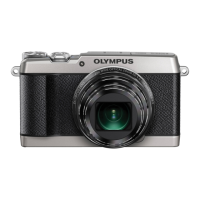
Do you have a question about the Olympus SH-2 and is the answer not in the manual?
| Type | Compact Digital Camera |
|---|---|
| Optical Zoom | 24x |
| Lens | Olympus Lens |
| ISO Range | 100 - 6400 |
| Video Resolution | 1920 x 1080 |
| Display | 3.0-inch LCD |
| Screen Size | 3.0 inches |
| Image Stabilization | Sensor-shift image stabilization |
| Connectivity | Wi-Fi |
| Image Processor | TruePic VII |
| Digital Zoom | 4x |
| Weight | 271 g (including battery and memory card) |
| Sensor Type | 1/2.3-inch CMOS |
| Megapixels | 16 |
| Effective Pixels | 16 |
| Aperture Range | f/3.0 - f/6.9 |
| ISO Sensitivity | Auto, 200, 400, 800, 1600, 3200, 6400 |
| Image Sensor | CMOS |
| Shutter Speed | 1/2000 sec - 1/4 sec |
| Video Recording | Full HD |
| Battery | LI-92B Lithium-ion |
| Focal Length | 4.5-108mm (25-600mm equivalent) |
| Battery Life | Approx. 380 shots (LI-92B) |
| LCD Screen | 3.0-inch LCD, 460k dots |
Step-by-step guide on how to properly insert and remove the battery and memory card.
Learn the fundamental steps to capture still images using the camera's shutter button.
An overview of the different shooting modes available on the camera dial.
How to shoot movies effectively in nighttime or low-light conditions.
How to select and use different flash modes for optimal lighting.
How to adjust camera exposure to make photos brighter or darker.
Choosing between auto, red-eye reduction, fill-in, or off flash modes.
Adjusting exposure compensation values for precise brightness control.
Setting the white balance to accurately represent colors under different lighting conditions.
Configuring sequential shooting speeds and self-timer options.
Selecting the resolution and file size for still photographs.
Selecting the resolution and frame rate for movie recordings.
How to reset camera shooting functions back to their original default values.
Choosing between fine or normal compression for still image quality.
Adjusting settings to brighten subjects that are underexposed due to backlighting.
Selecting AF modes like Face/iESP, Spot, or AF Tracking for precise focusing.
Choosing between ESP or Spot metering for accurate exposure readings.
Activating image stabilization to minimize blur caused by camera movement.
Using Super-Resolution Zoom to capture higher quality images with enhanced detail.
Applying image stabilization specifically for movie recording to reduce blur.
How to select and delete specific photos or movies from the camera.
How to format the memory card or internal memory, erasing all data.
Configuring the camera's internal clock for accurate date and time stamping of photos.
Selecting and transferring photos and videos from the camera to a smartphone.
Operating the camera and taking pictures remotely using a smartphone.
How to connect the camera to a television using AV or HDMI cables.
Playing back recorded images and movies on a TV screen for review.
Transferring photos and videos from the camera to a computer for storage and editing.
Solutions for common issues related to the camera's battery and power supply.
Steps to take when encountering errors or issues with the memory card.
How to fix problems where the shutter button does not take pictures.
Techniques for achieving sharp focus on subjects, including those not centered.
Methods to minimize blur caused by camera shake during shooting.
Tips for capturing images with the correct brightness and exposure levels.
Essential precautions for safe operation, cleaning, and product handling.
Guidelines to prevent battery hazards like leakage, overheating, or explosion.
Precautions for safe camera operation, including avoiding flammable gases and wet conditions.
Detailed instructions for handling batteries to prevent damage and ensure safety.
Further precautions for handling the camera in various environmental and operational conditions.
Best practices for battery inspection, usage, charging, and storage.
Strong recommendation to use only genuine Olympus rechargeable batteries and accessories.
Precautions related to using the wireless LAN function, including regulatory compliance.
Information regarding the manufacturer's limited warranty for the product.
Specific exclusions from the limited warranty coverage for products and accessories.
Steps to follow for requesting repair service and submitting the product.
Specific warranty terms and conditions applicable to customers in Europe.
Specific warranty terms and conditions applicable to customers in Asia.
Detailed technical specifications of the camera, including sensor, lens, and connectivity.
